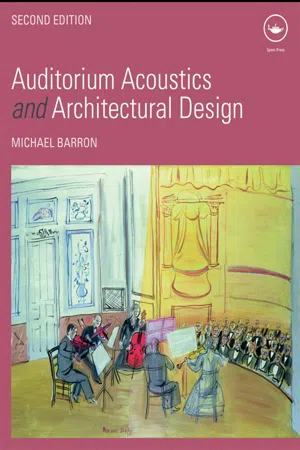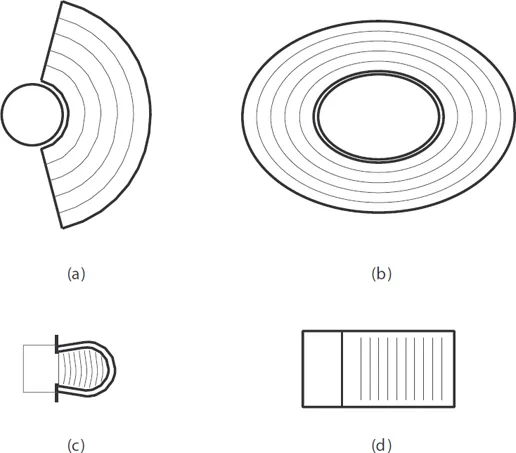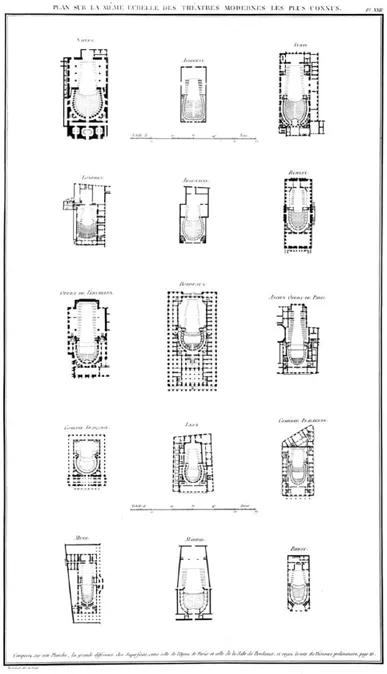
This is a test
- 504 pages
- English
- ePUB (mobile friendly)
- Available on iOS & Android
eBook - ePub
Auditorium Acoustics and Architectural Design
Book details
Book preview
Table of contents
Citations
About This Book
Modern concert halls and opera houses are now very specialized buildings with special acoustical characteristics. With new contemporary case-studies, this updated book explores these characteristics as an important resource for architects, engineers and auditorium technicians.
Supported by over 40 detailed case studies and architectural drawings of 75 auditoria at a scale of 1: 500, the survey of each auditorium type is completed with a discussion of current best practice to achieve optimum acoustics.
Frequently asked questions
At the moment all of our mobile-responsive ePub books are available to download via the app. Most of our PDFs are also available to download and we're working on making the final remaining ones downloadable now. Learn more here.
Both plans give you full access to the library and all of Perlego’s features. The only differences are the price and subscription period: With the annual plan you’ll save around 30% compared to 12 months on the monthly plan.
We are an online textbook subscription service, where you can get access to an entire online library for less than the price of a single book per month. With over 1 million books across 1000+ topics, we’ve got you covered! Learn more here.
Look out for the read-aloud symbol on your next book to see if you can listen to it. The read-aloud tool reads text aloud for you, highlighting the text as it is being read. You can pause it, speed it up and slow it down. Learn more here.
Yes, you can access Auditorium Acoustics and Architectural Design by Michael Barron in PDF and/or ePUB format, as well as other popular books in Architecture & Architecture General. We have over one million books available in our catalogue for you to explore.
Information
1 Introduction
Our echoes roll from soul to soul,
And grow for ever and for ever.
Blow, bugle, blow, set the wild echoes flying,
And answer, echoes, answer, dying, dying, dying.
And grow for ever and for ever.
Blow, bugle, blow, set the wild echoes flying,
And answer, echoes, answer, dying, dying, dying.
(The Princess, Tennyson)
‘Theatre design is based on hard facts and is rarely a matter of inventing new forms of theatre. The architect works within a large number of constraints, some of which are self-imposed, and if inventiveness comes into it at all, it is in the way that theory is put into practice.’ These words by the architect Peter Moro (1982) referred to theatre design, but they can equally well be applied to all forms of auditorium design. Many a designer must have greeted the prospect of a new auditorium with ideas of creating a totally new form or of returning to the purity of classical models, only to find his options becoming progressively more limited, with consultants from other disciplines criticizing one feature after another. As with all buildings, structural needs can limit freedom and architectural style is a balance between respect for precedents and current fashion. But for auditoria, there are the additional constraints in planning for good visual conditions and sightlines, of meeting certain social demands in regard to layout of seating and not least providing good acoustic conditions. The designer has to remain continually aware of the relationship he is creating between performer and audience, striving to make it as intimate as possible. Designing auditoria is a complex, elaborate but highly constrained exercise.
All auditoria rely on both visual and acoustic stimulation. Tennyson is referring above to the acoustic response in a mountainous landscape, in which echoes add to the visual imagery and create a sense of space. At the scale of concert halls and theatres, acoustic reflections are no less significant in creating a sense of space, but the ear does not perceive as discrete events or echoes the thousands of reflections it receives. It blends them into a total experience. Only certain aspects of the sound are used to establish the size and character of the enclosed space. The ear also establishes the direction of the sound source and extracts the information content where possible. A world in which the ear was unable to combine sound reflections was described by the Rev. Brewer (1854):
If the ear ... were capable of appreciating every impulse, the confusion of sounds would be truly terrific. ... Every sound in our houses, every word in our churches, would be repeated ten thousand times. We should hear the direct sound of one syllable mingled with the reflections of another, and both recurring so frequently, that language would be a Babel of ‘confusion worse confounded’. The voice of affection and of love, so tranquil, so soothing, and so gentle, would be a clatter more painful than the gibbering of a stammerer.
These are very perceptive comments for the time; the Rev. Brewer would have had to wait a century for a quantitative description of the workings of the ear, which enables us to avoid this ‘clatter’. The discussion of auditorium design and development on the basis of precedent were well established in Brewer’s day, even if not on a particularly scientific basis. Development from precedent dates of course from the classical Greek era, but sadly no contemporary discussion survives of the development of the earliest theatres. The earliest written record comes from the Roman Vitruvius in the first century BC (Vitruvius, 1960). He appears to base his geometric prescriptions for designing Greek and Roman theatres on an understanding of acoustics. But the validity of his arguments depends on favourable analogies with modern concepts. The most valuable information on ancient classical auditoria is to be gleaned from the surviving examples. The fan-shaped plan and the arena form both became highly developed in classical times and remain a constant point of reference for present design (Figure 1.1). The development of these dominant auditorium plans through the centuries is particularly fascinating (Barron, 1992).
Discussion of auditoria as a building type has a respectable history. The first of its genre, Dumont’s Parallèle de plans des plus belles salles de spectacles of 1774 contains, as the title indicates, comparisons of plans plus a few sections of then existing theatres and opera houses. Dumont also proposes his own designs with vast concave domed ceilings, which would now give any acoustician nightmares. Louis (1782) included comparative plans in the account of his Bordeaux Grand Théâtre (Figure 1.2) Contant and Filippi’s Parallèle of 1860 is a thorough review of the major west European theatres. Containing drawings and text, it discusses 33 theatres and became the standard work on proscenium theatre design. In the late nineteenth century, European theatres and opera houses experienced a building boom. By 1896 Sachs could fill his monumental three-volume Modern opera houses and theatres with extensive detail about more than 50 theatres completed since Contant’s earlier survey. This great work remains a tribute to many of the great houses destroyed in two world wars. Of our own time the closest book in the same vein is Izenour’s Theater design (1977). This is lavishly illustrated but is more partisan than its predecessors, with discussion leading from ancient theatres to modern American multi-purpose performing arts centres. For an architectural analysis, Chapter 6 on ‘Theatres’ in Pevsner’s A history of building types (1976) is typically erudite.

Figure 1.1 Historically dominant auditorium plan forms: (a) classical Greek theatre (fan-shape plan); (b) classical Roman arena; (c) baroque theatre (horseshoe plan); (d) nineteenth-century rectangular concert hall

Figure 1.2 Plans of major eighteenth-century theatres to the same scale (V. Louis, 1782)
The literature for concert hall design is more recent than for theatres. Somehow the history of concert hall development had not been treated until Forsyth’s valuable Buildings for music appeared in 1985. The first major review of the acoustics of concert hall buildings was Beranek’s Music, acoustics and architecture (1962), which surveyed 47 world-famous concert halls and seven opera houses. Beranek pioneered analysis of auditorium acoustics on the basis of several independent subjective qualities, such as ‘intimacy’, ‘liveness’ and ‘warmth’. Beranek has since revised his earlier book twice in 1996 and 2004; the most recent considers 82 concert halls and 18 opera houses. The strengths and weaknesses of his surveys are considered in section 3.2. Other reviews of concert hall designs include Talaske et al. (1982), Lord and Templeton (1986), Forsyth (1987) and Hoffman et al. (2003).
Beranek’s 1962 book was the first to seriously attempt a complete explanation of auditorium acoustics and to answer the many misconceptions on the subject. Acoustics for concert halls, theatres and opera houses is frequently referred to as an inexact science, or worse, an area of myths. While modern technology and computers are considered to be reasonable design aids for a new auditorium, the success of old halls is often considered to be due to secret ingredients. The suggestion, for instance, that concert halls mature with age is still prevalent, as if they behaved like good claret. Wood is often quoted as the optimum material to line concert halls, just because violins are made of the same material. The presumed inaccessibility of acoustic knowledge is long standing. Vitruvius, commenting on the musical basis of acoustics, suggested that: ‘Harmonics is an obscure and difficult branch of musical science, especially for those who do not know Greek’. Vitruvius considered that sound propagated curving upwards rather than just horizontally. Interestingly he justified the choice of raked seating not primarily for visual reasons but to optimize the movement of the ‘ascending voice’. The ancient Greeks had, of course, studied resonance of stretched strings and found that harmony depended on simple arithmetical ratios. Such mathematical purity led to the concept of ‘the music of the spheres’, which so appealed to the Renaissance mind. European scientists like Boyle and Newton in the seventeenth century furthered understanding of sound behaviour, and among other things demolished the notion of music in planetary space. In the ‘Age of Reason’ the first attempts were made at relating auditorium form to acoustic behaviour, with Patte (1782) proposing elliptical plans and Saunders (1790) circular ones. Both plan forms would now be considered dangerous due to focusing by concave surfaces.
Little further progress was made towards understanding the acoustics of rooms in the nineteenth century. A rare voice of inspired understanding is found in the comments of Dr R.B. Reid in 1835, when he said that ‘any difficulty in the communication of sound in large rooms arises generally from the interruption of sound produced by a prolonged reverberation’. Reid successfully advised on acoustic treatment of the contemporary House of Commons, Westminster (see Bagenal and Wood, 1931). In Germany, Langhans published a remarkable book in 1810 in which he not only shows that he correctly appreciated how early reflections enhance intelligibility but also came close to understanding the independent role of reverberation (Izenour, 1977; Hartmann, 1990). This work appears not to have reached England or France. Another advance was made by Scott Russell (1838) who calculated the optimum floor profile in long section for good vision and hearing. The ideal profile is curved to provide equal-seeing and ‘isoacoustic’ conditions. (It is notable that Scott Russell equates vision and sound in this respect, as this is still assumed today.) But concerning useful advice for the architect, the situation remained woeful regarding suggestions for suitable room form and size for good acoustics. Charles Garnier, architect of the Paris Opéra, understandably complained in 1880:
It is not my fault that acoustics and I can never come to an understanding. I gave myself great pains to master this bizarre science, but after fifteen years’ labour, I found myself hardly in advance of where I stood on the first day. ... I had read diligently in my books, and conferred industriously with philosophers – nowhere did I find a positive rule of action to guide me; on the contrary nothing but contradictory statements.
Somewhat ironically, in the face of such scientific ignorance, elaboration on the basis of precedent produced the rectangular ‘shoebox’ concert hall, some examples of which are still considered by many to have the world’s best acoustics. In the case of theatres, many large playhouses built during the theatre-building boom around 1900 are still used and function surprisingly well acoustically. The state of the art in 1861, or rather its lack, was summarized by Roger Smith in his Acoustics of public buildings. Smith failed to reconcile the conflicting evidence from the men of science. Even in the major theoretical work of the period, Lord Rayleigh’s Theory of Sound, which first appeared in 1877/8 but is still extensively referred to, the comments on room acoustics are limited to generalities (Vol.2, §287):
In connection with the acoustics of public buildings there are many points which remain obscure. ... In order to prevent reverberation it may often be necessary to introduce carpets or hangings to absorb sound. In some cases the presence of an audience is found sufficient to produce the desired effect.
The pleas of Garnier and Smith were answered on the other side of the Atlantic, when in 1895 Sabine began his pioneering work on room acoustics. At a time when physicists were making revolutionary early discoveries in atomic physics, the relative tardiness of concern for the commonplace experience of sound in rooms deserves comment. Two reasons can be advanced for this lack of progress. Firstly the fundamental relationship for sound in rooms requires a statistical rather than simply linear treatment. The linear approach, which can be applied to the single sound wave, has to be applied a thousand times over to provide a complete picture of sound travelling from performer to listener. From this plethora of information, selection of the relevant attributes remains a problem to this day. The second problem until the 1920s was that of measurement. The ear is a highly sophisticated organ but its very adaptation to understanding sounds in enclosed spaces precludes its use as a fully analytic instrument in the scientific sense. The advent of microphones and electronics was obviously a great breakthrough.
In the circumstances, Sabine’s achievement was all the more remarkable. W.C. Sabine was an Assistant Professor in the Physics Department of Harvard University. His previous work had been in optics and electricity, when the President of the University asked him to find a solution to the appalling acoustics of the lecture room of the newly completed Fogg Art Museum (Figure 1.3). Sabine quickly realized that there was excessive reverberation in the lecture room (he measured the unoccupied reverberation time as 5.5 seconds; Sabine, 1922). Consultation of the literature would have revealed that this could be reduced by installing sound absorbing material, but Sabine chose to undertake a fundamental investigation into the behaviour of sound in enclosed spaces. He developed a technique for measuring the decay time of residual sound after an organ pipe was switched off, using nothing more than the observer’s ears and a stop-watch. Measurements were made of this time, now known as the reverberation time, while different lengths of absorbent cushion were brought into the room from a neighbouring lecture theatre, up to the point where the time had been reduced to 0.75 seconds. Changes to improve the acoustics of the lecture room were made in 1898; the room was finally demolished in 1973 (Cavanau...
Table of contents
- Cover Page
- Title Page
- Copyright Page
- Preface
- Preface to the first edition
- Foreword
- 1 Introduction
- 2 Sound and rooms
- 3 Acoustics for the symphony concert hall
- 4 The development of the concert hall
- 5 British concert halls and conclusions for concert hall acoustics
- 6 Chamber music and recital halls
- 7 Acoustics for speech
- 8 Theatre acoustics
- 9 Acoustics for opera
- 10 Acoustics for multi-purpose use
- 11 Multi-purpose halls in Britain
- 12 The art and science of acoustics
- Appendix A Sound reflection and reverberation calculation
- Appendix B Objective measures for music auditoria
- Appendix C Further objective results in concert halls
- Appendix D Objective measures for speech auditoria